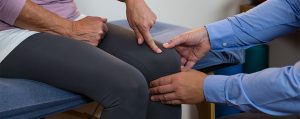A Complete Core Workout for Runners
Running can place up to 3 times your body weight of force on the body. Because of this extremely high demand, having a strong core is important. The core muscles include the diaphragm, transverse abdominus, rectus abdominus, obliques, pelvic floor, and multifidus. These muscles provide stability to the trunk when the arms and legs are being used, as well as through an axial load (which occurs during running). A strong core to absorb all of the force described above with running is critical to prevent injuries. Below you will find a complete core workout to help encourage core strength to help prevent injuries.
Hip Pain in Runners
With the fall weather and cooler temperatures here, running has become a more popular form of exercise. With increased running also commonly comes an increase in injuries, specifically hip pain. Hip pain can have a variety of causes, and it can be structural, overuse, weakness, etc. Most commonly in runners, hip pain is caused by increasing mileage too quickly and muscular imbalances/weaknesses. Hip pain can be prevented in runners by increasing mileage at an appropriate rate, performing a dynamic warm-up and cool-down, and performing hip strengthening exercises. Below you will find strategies to help prevent hip pain while running.
Is it Safe to Run with Knee Pain?
Generally speaking, exercise should not be painful. Pain is an alarm system within the body telling you something is not working properly. So, should you keep running when your knee hurts? When do you go to the doctor? Will they ask you to stop running? Can you ignore it? Stop right there.
Maximize your Running Performance with a Video Gait & Running Analysis
According to the 2020 Sports & Fitness Industry Association report, approximately 50 million Americans participate in some variation of running or jogging. That’s 15 percent of the United States population. With the recent pandemic and gyms being temporarily closed, even more, people took up running to get in their daily exercise. Whether a weekend warrior runner or a competitive athlete, a video running analysis can benefit you.
5 Exercises For Runners With Ankle Pain
Everyone knows exercise is a key component to staying healthy. With nicer weather comes more outdoor activities, including running. Running produces a ground reaction force of 2.5 times the runner’s body weight, while walking produces only 1.2 times the runner’s body weight1. With the increased demand from ground reaction forces and the foot being the first to come in contact with the ground, ankle pain can be common in runners. So, what can we do to prevent injury, specifically to the ankle, with the increased demand required during running? Here are five exercises to improve and prevent ankle pain, specifically when running.
The Basics: Sprains, Strains, and Fractures…What’s The Difference?
“I sprained my hamstring!” “I didn’t break it. I fractured it.” “He had a bad ankle strain.” Physical therapists, occupational therapists, and most medical professionals cringe when we hear this at parties, in the media, or our clinic. The tactful among us do their best to resist the urge to correct, but let’s face it, we are only human.
Tips from a PT: Maintaining Endurance During the Winter
Winter is when many of us hibernate inside to watch Netflix and make sweet treats in the kitchen. But if you are someone looking to build your endurance for later in the year – such as for a race or general fitness – you do not want to take these winter months off before resuming activity in the spring. If you are usually active in the other three seasons of the year, it would greatly behoove you to maintain regular activity in the winter months. Winter is the perfect time for endurance athletes to take it a little easier and focus on building and maintaining their base for a more efficient aerobic system. Here are some tips to consider during the cold months:
3 Reasons Why You Should Stay Active While Injured
We all understand that sometimes injuries can happen. Most people have experienced pain or an injury at some point in their lives. Although injuries can happen to anyone, how we choose to manage them determines our outcomes. Injuries are often underestimated in severity, and people feel they can “give it time” and wait to see if it will get better. This may work for some injuries, but often people are searching the internet or coming into our clinics looking for more guidance on how to get better, quicker.
